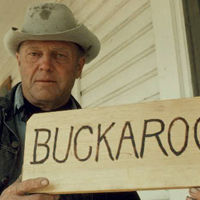 |

在第96號牧場土地上,牛仔被稱為Buckaroos

|
 |
|
 |
第96號農場 (Ninety-Six
Ranch) 在1979年的最後一次放牧:1979年10月7日
為了讓這些牛隻能夠往正確的方向走,牛仔騎馬的位置必須比牛隻要高,而且要帶領牛隻走下山。為了要把牛隻趕出灌木叢,牛仔們必須要猛力敲打鋁罐或裝滿石頭的罐子,同時還得小心不能驚嚇到牛群。
當這項工作進行到最後一步時,所有在夏天出生的小牛都會被烙上印記,有些牛會被賣掉。冬天的時候,剩下來的牛群則會被收容在附近的牧場裡。到了春天,新生的小牛也會被烙上印記,牛仔會再把牛群帶回山上享受青草,並逐漸長大。當秋天來臨之時,牛仔又要再把牛群們趕回山下。
To get the herd going in the right direction, the buckaroos rode to a site above the cattle, and then headed toward them down the hill. To drive the cattle from a thicket, they banged on tin cans or shook cans full of stones, always being careful not to cause a stampede.
At the end of the round up, any calves born during the summer were branded, and some of the cattle were sold. The remaining herd was kept in nearby pastures during the winter. In the spring, the new calves would be branded and turned out with the rest of the cattle to grow fat on the summer grass in the mountains. When fall rolls around again, the buckaroos head out after them once again.

 3/3 頁
3/3 頁

|





